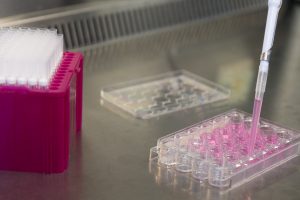
Dr Carmine Gentile and his team have been working on research enabling them to re-create a heart attack in a test tube using human cells.
In a world first, they have developed a new way to study and prevent a heart attack before it leads to heart failure thanks to their innovative technology based on bioengineered mini-hearts. Their research has enabled them to observe and understand which molecules change and which cells die following a heart attack. This research provides new opportunities to study how to prevent a heart attack and how to minimise long term damage following a heart attack.
To read their published paper on this click here.
Every ten minutes, one Australian suffers from a heart attack. This is characterised by the narrowing of one or multiple coronary arteries due to the build-up of fat in blood vessels (“atheroma”). This blocks blood from flowing in certain areas of the heart and creates an infarct zone. Patients are not always able to recognise symptoms, which may include headache, dizziness, chest pain and nausea. Prolonged lack of oxygen and nutrients following a heart attack may cause irreversible damage to the heart, which can cause the heart to fail over time.
Despite the latest advancements in cardiovascular research and medicine, including improved outcomes for patients that receive a stent to reopen the blocked blood vessel, one out of four heart attack patients will develop heart failure. This means that over 10,000 Australians will develop a failing heart every year, with the potential need for a heart transplant. Currently, only approximatively 100 hearts are transplanted in Australia every year, with limited survival after the procedure.
The work of Dr Gentile and his team has enabled them to delve into the interaction of the molecules and cells that differ between a healthy and an infarcted human heart. They have uniquely identified that following a heart attack not all the cells die in the absence of oxygen. This world first has shown that whilst most muscle cells stop contracting because they have died, there are other cell types composing blood vessels that do not die completely.
Using state-of-the-art research techniques, this recent research has helped them identify which molecules change following a heart attack. Altogether, their results will help them to identify new approaches to investigate how to prevent and treat the irreversible damages caused by a heart attack which currently, is irreversible.
Thanks to their work there is now a new tool to significantly advance cardiovascular research to not only visualise a heart attack in a test tube but identify and study its unique mechanisms.
The multidisciplinary team comprises experts in cardiovascular engineering, pharmacology, and medicine between UTS, the University of Sydney, UNSW and several internationally-respected Universities and Institutes. As a result of this breakthrough, they are now working on new strategies to hopefully save the lives of many patients before they develop irreversible damage, typical of heart failure patients.


